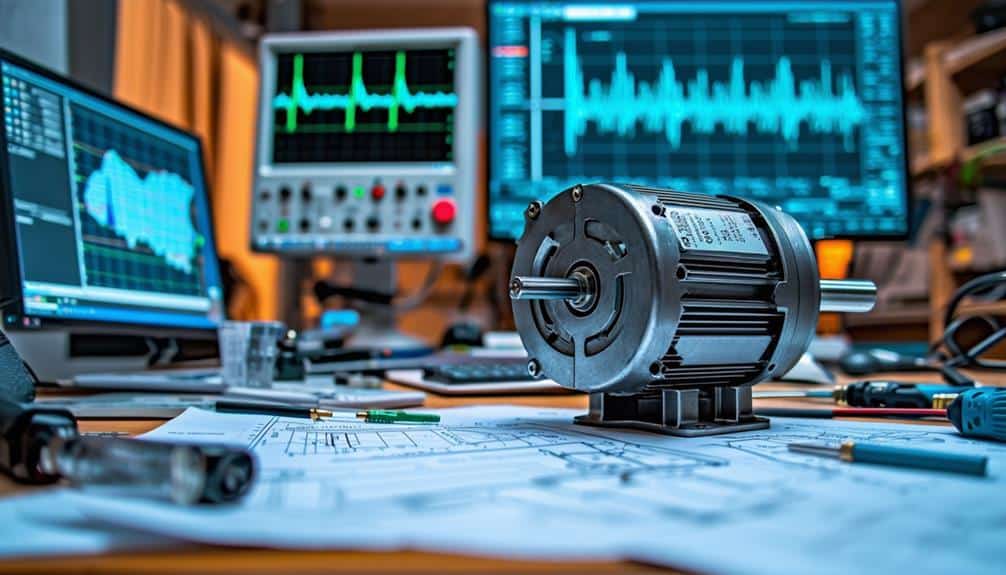Submit Your Request
Please fill out the form below.
Please fill out the form below.
Need a custom solution?

When it comes to controlling DC motors, it’s vital to understand the intricacies of the different systems at play. From the straightforward On-Off control system to the more sophisticated Field-Oriented Control (FOC), each method offers unique advantages and applications.
How these systems function and the scenarios in which they excel can significantly impact the performance and efficiency of your motor operations.
So, let’s explore the nuances of these control systems and methods to optimize your DC motor control for various industrial and technological needs.
To effectively control a DC motor, understanding the basic principles of DC motor control is essential. DC motor control involves manipulating the speed and torque of the motor to achieve desired performance. Speed control is the regulation of the motor’s rotational speed, while torque control is the management of the motor’s rotational force.
Speed control in DC motors can be achieved through various methods such as armature voltage control, field flux control, or a combination of both. By adjusting the armature voltage, you can control the speed of the motor. Similarly, altering the field flux affects the motor speed. Torque control, on the other hand, is typically accomplished by adjusting the armature current. Increasing the armature current results in higher torque output from the motor.
Understanding the relationship between speed control and torque control is crucial for effectively managing the performance of a DC motor in various applications. By mastering these basic principles, you can optimize the operation of DC motors to suit specific requirements.
Understanding the On-Off Control System is fundamental for effectively managing DC motor performance in certain applications where discrete control is sufficient for the desired outcomes. This control method operates by turning the motor fully on when a specific setpoint is reached and completely off when it falls below that threshold. One key aspect of On-Off Control is hysteresis control, which prevents rapid switching between on and off states due to minor fluctuations in the system. By introducing a hysteresis band, the system becomes more stable and less susceptible to noise or minor disturbances.
Moreover, time delay control is another critical element of the On-Off Control System. Time delays can occur between the motor response and the control action, impacting the overall system performance. Understanding and minimizing these delays are essential for optimizing the efficiency and accuracy of the DC motor control. While On-Off Control is straightforward and cost-effective, it may not offer the precision or smoothness of operation compared to more advanced control methods like Pulse Width Modulation (PWM), which we’ll delve into next.
Pulse Width Modulation (PWM) is a modulation technique commonly used in controlling the speed of DC motors.
Mastering PWM techniques is crucial for optimizing the performance of DC motors in different control systems.
Utilize Proportional-Integral-Derivative (PID) control to enhance the precision and stability of DC motor speed regulation in control systems. PID control is a widely used technique due to its effectiveness in controlling systems. When implementing PID control for DC motors, tuning methods play a crucial role in optimizing performance. The PID controller consists of three terms: proportional, integral, and derivative, each contributing uniquely to the control loop.
PID tuning methods involve adjusting these three terms to achieve the desired system response. The proportional term provides an output based on the current error, the integral term considers past errors over time, and the derivative term predicts future errors based on the rate of change. By fine-tuning these parameters, you can optimize the control system’s response to different operating conditions.
PID control loop implementation involves integrating the PID algorithm into the control system software or hardware. This integration allows the controller to continuously calculate and adjust the control signal to maintain the desired motor speed accurately. Proper PID tuning and implementation are essential for achieving precise speed regulation and stability in DC motors within control systems.
In control systems for DC motors, Field-Oriented Control (FOC) is a strategy that enables precise control of motor speed and torque by decoupling the flux and torque components in the motor’s magnetic field. FOC is a sophisticated control method that focuses on aligning the motor’s magnetic flux with a reference frame to achieve optimal control performance.
Here are four key aspects of Field-Oriented Control (FOC) in DC motors:
In real-world applications, efficiency comparisons of different control systems for DC motors reveal crucial insights. Assessing performance metrics in practical settings provides valuable data. You can make informed decisions based on these comparisons for optimal system operation.
Yes, control systems for DC motors can be seamlessly integrated with IoT platforms for remote monitoring and control. This integration allows for real-time data collection and analysis, enhancing operational efficiency and enabling predictive maintenance strategies.
When implementing advanced control systems like Field-Oriented Control (FOC) for DC motors, challenges arise in tuning parameters, handling sensor inaccuracies, and ensuring system stability. Solutions involve robust tuning algorithms, sensor redundancy, and fault detection mechanisms.
When using PWM control for DC motors, safety considerations are crucial. Efficiently comparing PWM methods can enhance real-world applications. Ensure proper insulation, grounding, and current limitations for a secure operation.
In the long term, environmental factors like temperature, humidity, and vibration impact DC motor control systems. Performance degradation occurs due to these influences. Implementing proper maintenance strategies is crucial to mitigate these effects and ensure optimal system functionality.
In conclusion, various control systems and methods for DC motors were discussed, including:
Each system offers unique advantages and applications in regulating the speed and direction of DC motors.
Understanding these control systems is essential for optimizing performance and efficiency in a wide range of industrial and commercial applications.